All Dressed Up and 300K to Go: Turning My Roadbike into a "Rando Bike"
Last weekend I rode the longest brevet I have successfully completed to date: the 189 mile Quiet Man 300K on the West Coast of Ireland. As I've sheepishly described in the ride report, all sorts of stuff went horribly wrong on this ride. Thankfully, one thing that didn't let me down was my bicycle's setup. In fact, this is probably the most content I've ever been with a bike on a long distance event.
The bike I rode was my everyday roadbike (a Seven Axiom S) which I've now owned for over 2 years and could not be happier with. While I did not acquire it specifically for long distance cycling, over time it became clear that it suited me for this purpose exceedingly well. Even with skinny tires on rough roads the ride quality feels fantastic, be it after 10 or 100 miles. It is also a very fast, lightweight machine, allowing me to push myself over long distances with little fatigue.
Once I began using my roadbike for brevets last Spring, the one thing I started to wish for was lower gearing. To climb a steep hill in standard road gearing on a club jaunt was one thing, but to do so over and over in the course of a long haul ride with Blalockian amounts of elevation gain was another. I had a hybrid drivetrain setup in mind, but stalled in getting it done, worried that putting too-low gears on my roadbike might limit its usefulness. Happily this turned out not to be the case. My bike now rocks a hybrid "SRAMpagnolo" drivetrain with sub-1:1 gearing, and there is no going back from the fabulousness of this setup.
So in essence my everyday roadbike is a fast, comfortable bike that is equipped with go-anywhere gearing. For me, that is at the heart of what makes it a suitable brevet bike. Accessories are certainly useful. But these core characteristics are essential.
Getting back to accessories… To each their own, but when cycling for sport (as opposed to transport), I prefer to ride with the most minimal setup I can get away with. So, I only equip my roadbike with fenders, lights, excess luggage, or anything but the basics, if I feel the situation warrants it. That said, a 300km brevet in a remote area was just that sort of situation, and so my bike and I played some dress-up.
In addition to the small under-the-seat bag I normally ride with, I added a handlebar bag. I find that having a bag up front is handy on long rides, allowing me to retrieve essential items faster and easier than from a saddlebag. My friend Emily of Dill Pickle makes one that can be used quite comfortably without a supporting rack, allowing me to install and remove it, with minimal commitment (details on this bag forthcoming).
The forecast for the 300K called for steady rain for at least the first half of the day, so with a heavy sigh I installed some fenders. On roadbikes with skinny tires and tight clearances I am more or less content using the modular plastic Crud Road Racer mudguards. The Cruds are lightweight, offer excellent coverage and don't rattle. Moreover, their modular no-tools-required design makes them physically effortless (albeit logistically elaborate until you get the hang of it) to install/ adjust/ remove, which means I can do it myself even when my hands are tired.
But every fender has its drawbacks, and one issue with the Cruds is their tendency to lose bolts. When this happens, I find it easy enough to fix with a small zip-tie (I carry a few in my bag just in case)- not pretty, but a perfectly functional alternative to the native escape-prone bolts.
As far as tires, I stuck with the ones I normally have on this bike, which are Clement Strada LGGs in 700Cx23mm (in reality closer to 25mm). What I like about these tires is that they are puncture resistant with a kevlar belt, but feel supple and racy. I do not feel the need for fat tires when doing a paved ride, as my bike is perfectly comfortable with these over long distances on rough Irish roads.
For navigation, I use a combination of the brevet's official paper cue sheet and Garmin GPS route with turn-by-turn instructions. Knowing the 300K would take me longer than 12 hours to complete (around the time my computer battery dies), I brought a backup charger.
As the sun would not set until 9:30pm on the night of the brevet and we'd only ride 4 hours in the dark max, I was not concerned with procuring a dynamo generator setup for my bike. But I did take 3 separate high-power battery headlights just in case - two handlebar-mounted ones and one helmet-mounted.
To supplement, I also attached these teeny headlights to my bike's fork dropouts. Yes, I went a little overboard in this respect! - but last year's experience of the darkness being "too dark" was still fresh on my mind. As it turned out, the roads we were on were easy to navigate at night, so in the end I used only a single headlight with no trouble.
A single tail light, clipped onto my saddlebag's rear pocket was also perfectly sufficient. In the rear bag I carried tools, spare tubes, extra lights, and other supplies which I did not need to have at my fingertips while on the bike. As it happened, I never opened this bag during the 300K brevet. Oh the sleep I lose thinking how much faster I could have been without it. [Joking!! For heaven's sake.]
So that about sums it up. My everyday roadbike fitted with some removable fenders, a handlebar bag, and battery lights got me through a rainy 300k brevet in Ireland comfortably. Of course, every brevet is different. Every bike is different. And most importantly, every rider is different. This post is merely a description of my own setup. Mix, shake and stir - or ignore - according to taste!

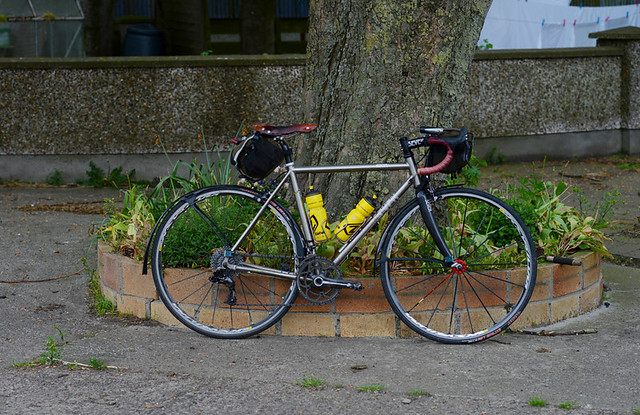
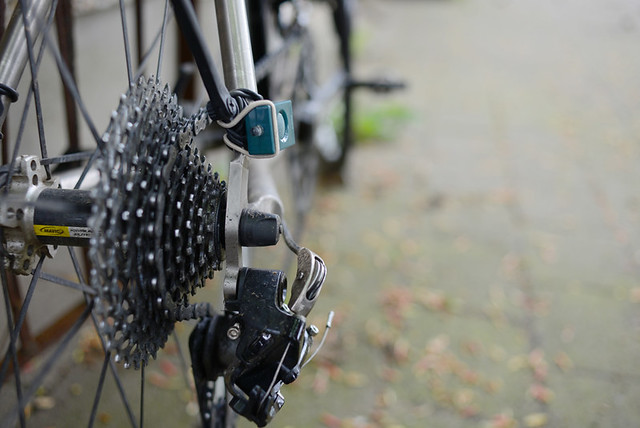
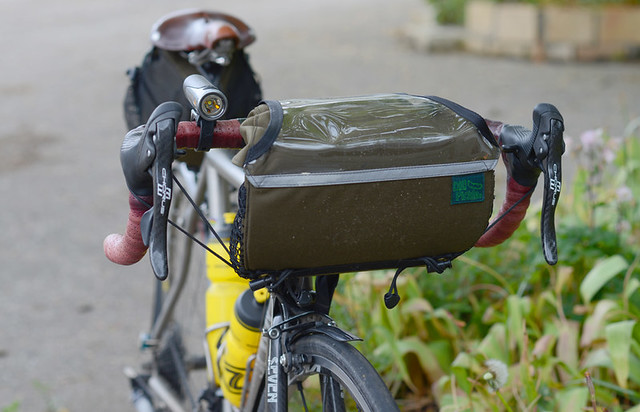
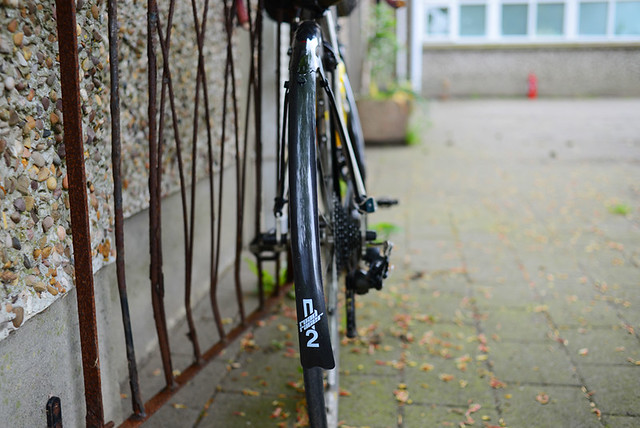
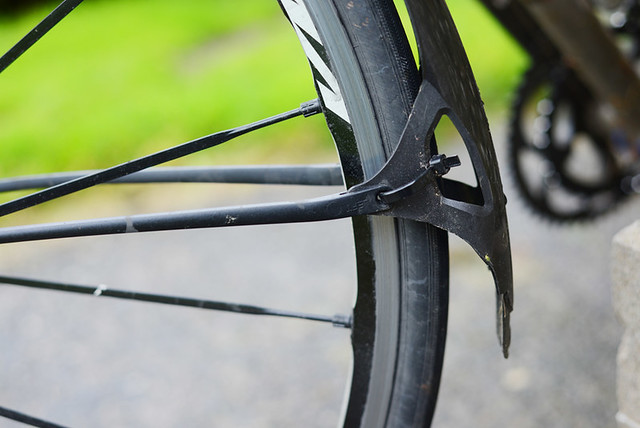
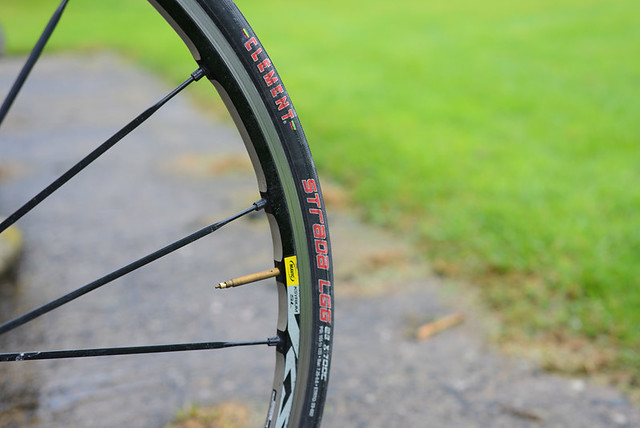

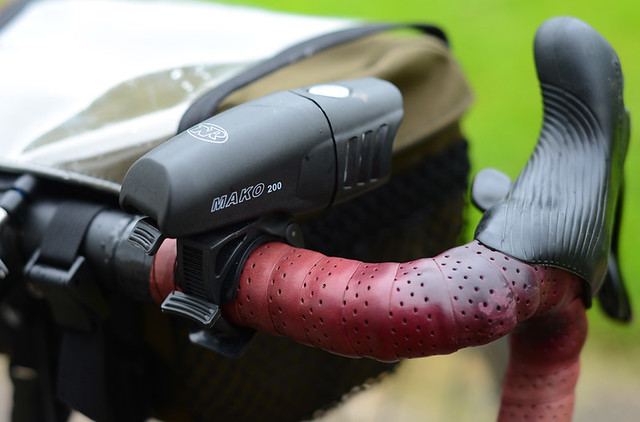
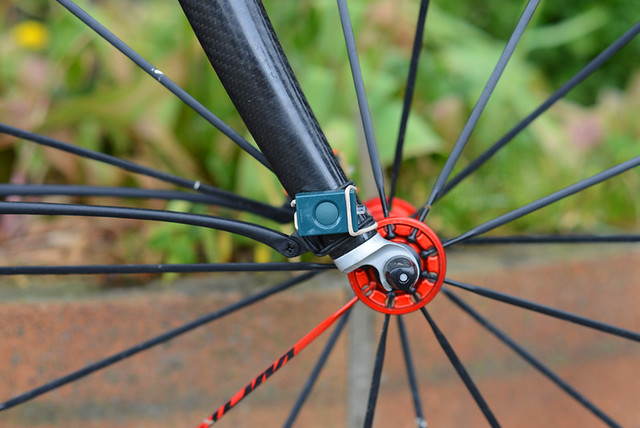
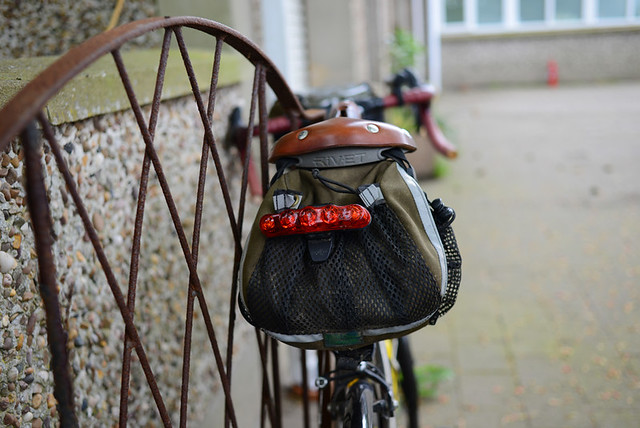
I am very excited to hear more about that handlebar bag, which I've been eyeing lately. I would like a fast(er), light(er) bike than my heavy porteur, but I am too spoiled by its carrying capacity to give up luggage entirely, and that handlebar bag seems like a nice solution for rack-less cargo space. How did you find the straps that go around the fork crown? They look like they would be very flappy in the apparent wind as you ride, but maybe that is not an issue in practice.
ReplyDeleteThis is a typical set up. Nothing unusual or special. Doesn't look like a re-enacted machine. It's modern, light and efficient.
ReplyDeleteOnly two water btls - enough? What tire pressures?
Hmmm. The 36T sprocket and getting it to shift is at least a little atypical. I don't see a lot of Berthoud saddles. Or is that an SA? Don't see those either. But yeah, it looks like a bike. Typical bikes are typically pretty good.
DeleteWorking on it way too hard I can come up with two critiques. Those valve stems are needlessly long. Harder to handpump too. And the little lights at the dropout are either useless or aimed too high. Some of the tiny lights are powerful and aiming them is tricky. Drives me crazy to be approached by a Las Vegas Christmas tree. Otherwise it's a real nice personal build from normal parts.
The HB bag is real nice. Will look forward to the full writeup.
"Doesn't look like a re-enacted machine."
DeleteDon't be so sure. Local roadies see the level top tube and leather saddle and find the whole thing very quaint.
Rider: "Lovely bike."
Me: "Thanks"
Rider (in his 40s): "…My Da used to have one just like it when I was growing up."
Me: "Really??.."
Rider: "…had a lovely old seat just like this one and everything"
Oh and two bottles were enough to last between stops, even with my increased water consumption. Don't think a 3rd set of cage bosses would be particularly helpful.
DeleteTire pressure - in Ireland it feels good to run them at 90PSI or so, which is slightly below recommended.
Anon 11:02 - No problems shifting with the 36t, no rubbing, and even in the dreaded big/big combo the thing runs surprisingly smoothly.
The saddle is a Rivet Independence.
The angle of the mini-lights probably looks wrong because the photo is tilted; it was pointing where it was supposed to in action. However, I turned everything off but a single tail light & headlight once I realised it was unnecessary.
Valve stems - really?
DeleteThe aim of my lights would be to cover as wide an area as possible, given the redundancy of a head- and helmet-light. Stupid wildlife.
The UK seems to be a bit behind the US in metal fetish-bike appreciation but they do know a fast bike is a fast bike.
I'd probably run 90/85 even. T'each.
Jim
DeleteI did say I had to work too hard to find the smallest thing amiss. It does happen that when handpumping (or even CO2 inflating) an overlong stem can break or pull from the tube. And it's dead weight and out of balance weight. Small stuff can be hammered to death. Dunno what they do currently, Campy wheels used to be balanced for valve-weight that would be provided by the customer and they would tell you how long that stem should be.
I know, just bustin' your chops.
DeleteThe valve base to tube interface is often the weakest link, failing way too often.
Thank you for spending the time to aim your lights. It matters to oncoming traffic whether 2- or 4-wheeled.
DeleteV @ 11:21
DeleteModern chain is pretty flexible laterally so cross-chaining is not the big deal it was once. Remember that once the default setup for a 'fast' bike was fixed gear. Chainline is super important to fixed riders. The old trackies shook their head at any multiple freewheel.
The old trackies did have a point. Pedalling forces -- any mechanical force -- does not easily change direction or turn around corners. When cross-chained there will always be friction and heat and wear and power loss. If it doesn't bother you go ahead and do it. If a different combination on the other chainring gives you a straighter chainline it's better and more efficient to shift there. Presuming you think of it and presuming it's not too much trouble to make the shifts. If you will be in that combination for an extended time the difference will add up.
Your explanation below of why you like having low gears available is very good. I would do the same if not committed to 5speed freewheels. Or if I had 20% grades in the neighborhood.
Yes. I don't mean that I regularly cross-chain as part of my riding style. But when I first got the setup, it was experimental and the idea was to test it thoroughly and give Seven feedback. So I deliberately stressed the drivetrain, including cross-chaining under load, "messy" shifting, etc., trying to find scenarios where the setup maybe would not perform optimally.
DeleteYou might try some Locktite on those pesky fender bolts. It seems to help when I've used it.
ReplyDeleteRegular blue Loctite is somewhat corrosive to many plastics. Either Loctite 425 or Permatex 19920 is better. Pricey options for something so small. Beeswax would be worth a try.
DeleteA nice road bike is a versatile machine.
ReplyDeleteOut of curiosity, if you did the Seven all over again, would you get fender mounts and long reach brakes? Or do you prefer the modular fenders and short reach set up?
I prefer the modular fenders and short reach brakes. Would not do a thing differently if I were ordering this bike again.
DeleteShort reach duals have better feel and are more powerful ime.
DeleteGood tip on using zip ties with the Crud fenders. I used to tighten the screws compulsively at every rest stop. I like your solution better.
ReplyDeleteA very useful post. Thanks.
ReplyDeleteInteresting how I'm the opposite with regard to lighting-- you had four headlights and only one taillight. I feel most comfortable with at least two taillights but feel no compulsion to have more than one headlight (provided that it's a dynamo headlight). Having been ass-ended on a bike before, my desire for multiple taillights obviously caters to a personal need that others might not share.
ReplyDeleteThe main reason I prefer puffier tires for paved riding in addition to off-road surfaces, is that in my experience around New England and NYS the gravel roads are actually smoother on a large scale, while rougher on a finer scale. Meaning, while gravel is bumpier than pavement, the bumps are small and fine, but the bumps from potholes and other forms of broken pavement, are larger and more jarring than what I usually find with gravel/dirt surfaces. That's right-- pavement is more jarring than dirt. So unless I'm cycling on glassy smooth pavement, I prefer wider tires.
I'd also guess that the Crud Racer mudguards aren't protecting the feet well-- coverage seems to end pretty high up on the front wheel.
Who do you take me for! I brought 3 tail lights along. But only ended up using that one.
DeleteThe Cruds do protect the feet pretty well. I took the picture before attaching the last, mud-flappy part to the front one, my fault. Seriously, for fenders that lightweight and commitment-free, they offer amazingly good coverage. Dry feet, dry butt, clean bike.
Suspension tech is a complicated matter.
DeleteNeat to see how you have adapted and adjusted your approach. I remember you writing about the different road bikes you saw at D2R2 (and maybe Kearsarge Klassic, I forget) and how you wondered that folks would be riding race-ish bikes on those often dirt-road conditions. Yet, you are there!
ReplyDeleteI'm curious- did you end up keeping the supposedly temporary rear derailleur setup you wrote about in the linked blog post? If you changed it, what did you change?
I mean, besides all the miles and work you've put in on yourself. ;)
This brevet was entirely paved Corey; otherwise I'd be riding on fat tires. The skinny tire folk at D2R2 and Kearsarge got lots of flats compared to the fat tire folk, so that alone seems like reason to avoid.
DeleteKept the original derailleur and mismatched rear wheel of the "experimental setup" - figuring if it ain't broke, don't fix it!
"The skinny tire folk at D2R2 and Kearsarge got lots of flats compared to the fat tire folk, so that alone seems like reason to avoid."
DeleteIndeed. I had forgotten your comments about all the flats you saw. Selective memory. :)
Good thing that Honey is so close at hand!
The "experimental setup" suits the rider, and therefore the bike.
What are your thoughts regarding Rivet saddles vs. Brooks? I don't know how many miles you've run up on that perch, but it looks like a lot. Did you find this one a quick break-in? How long do you think it will remain functional?
ReplyDeleteRivets are a different kettle of fish than Brooks, more like a Berthoud-SelleAnatomica hybrid. I've ridden on this one since last August, so I guess it's a keeper; will post a long-term review soon. The break in period took a couple hundred miles and it's continuing to change shape the more I ride it, but not anywhere near the sag-speed of Brooks. Can't tell you how long it'll hold up until it doesn't.
DeleteI find a lot of variation in Brooks. One of my Brooks Pro saddles took minimal time to break in and while it did not sag, it did feel a bit springy after a couple years. The other one has been on my bike for three years and close to 15 thousand miles and is still firm yet my sit bones are always happy.
DeleteI have a B17 that I purchased in 2005 that has been ridden on near-daily commutes year round since that time in Lincoln NE, Maynooth ROI, Minneapolis MN, and Lincoln again. Aside from scratches and nicks from scraping on walls, stairwells, etc., in profile it looks almost identical the B17 I bought in January of this year which has maybe 250 miles on it. All I've done is slather it with Proofide every once in a while, but it hasn't noticeably changed shape to conform with anything. Same thing with a Swift I got in 2008. Stained and scratched, but not sagging. Weird.
DeleteThe common rule for efficient spinning is around 85 RPM, so does your computer display your cadence?
ReplyDeleteL.
Yes. Mine tends to be in the 90s.
DeleteThe bike looks like a nice set-up. I sense the Seven was designed for this type of all day riding--It's in its element. It's nice to see your evolving sense of style in favor of light and functional.
ReplyDeleteRight?
DeleteInstalling the fenders is easy, "albeit logistically elaborate until you get the hang of it"
ReplyDeleteCan you elaborate?
Easy in the sense that the process does not require almost any physical hand strength or much dexterity. Elaborate in the sense that when you buy the Cruds, you get a sack of small pieces and have to figure out how they go together using minimal IKEA-esque instructions...
Deletefor me putting fenders on was a one way trip, they never come off. even when it isn't actually raining the road is so often wet enough to make the spray from the tires a problem
DeleteI'm curious from readers if they ever have chain issues on these long and isolated rides. What, in your experience is the average wear length of these light chains before before it's wise to replace?
ReplyDeleteBuy another, rotate every 1500-2500 miles, same cogset. Maximum wear on cogs that way. Chains can be cheap.
DeleteCarry spare links, including a master.
Thanks!
DeleteUse 9 or fewer cogs in the rear, lubricate with NFS, expect a minimum of 5000 miles. Unless you are large and strong and mash.
DeleteAlways best to measure your chain for wear. That means measuring, not a chainchecker tool. After a few measurements you'll know, but reacquaint yourself with the numbers next season.
I get well over 5k out of a cogset, 10sp.
DeleteCogset gets 5K, sure. Chain? I'm seeing 11 speed chains that are done after a mere thousand miles. Not mine, but criminy, there should be original factory lube live in those chains for 1000 miles. My personal best was a consistent 8500-9000 miles on Campagnolo/Rohloff SLT-99 chains when those could be had. Haven't done massive miles on one chain since the switch to NFS, just checked a Regina Black with about 3000 miles on it, 24 links is 12.010". I've a stack of old Regina Blacks and next time I mount one I'll have to check what the manufacturing tolerance is.
DeleteAs mentioned I rotate chains on the fast bike. Maybe 8k on two chains, but by that point the cogs are a bit sad, so off they all go.
DeleteFactory lube can go within a couple hundred miles I've found.
I don't keep track of miles anymore, battery in the 'puter died so I leave it. Just ride.
I like your approach here. A lightweight, fast, functional road bike generally optimized for daylight riding on paved roads, with a few modifications when needed. There is loud drum-beat of advice from both Rivendell and Bicycle Quarterly that "weight doesn't matter", "fatter tires are best", and a useful bike should have permanent fenders, and racks, and big bags, and generator hubs and permanent lights. In my area, I see lots of bikes decked out with all this stuff, whose owners overwhelmingly use the bikes for short rides, on paved roads, during the daytime, when it isn't raining! I find I'm at least 1 to 2 mph faster on my lightest bikes with 700x25 mm tires than on the bikes I have loaded up with wider tires, fenders, bags, and lights for commuting. Both approaches may have their place, but I find my lighter bikes are both faster and more fun to lift, carry, ride, and climb hills with than the ones I have decked out with a bunch of stuff I don't actually need for typical everyday riding.
ReplyDeleteWhen I blitz by one of these guys on the flat I have no idea what they're thinking but at least a couple of them have looked at the bike and, I'm sure, gone, "Holy sh* I need a new bike. Or at least another one."
DeleteI think Fixie Pixie had good thoughts on this....http://blayleys.blogspot.com/2014/03/whats-good-bike-for-brevets.html
DeleteThe latest BQ Compass tires are lighter than many 25s. BQ has tested and praised several fully integrated bikes - expensive yes - that are not all that much if at all heavier than many bikes sold as light way day riders.
DeleteRivendell does not recommend fully integrated bikes for road racing. In fact, Rivendell sells a light weight steel bike - the Roadeo - that does not easily if at all accommodate a lot of add ons.
Rivendell does suggest people not interested in racing consider how they will be using their bike and setting it up to best meet that use.
Here's a parallel from this side of the planet:
ReplyDeleteToday I talked to a few women riders in the midst of the Rapha Prestige Tour of California ride. Bunch of girls haulin' ass, cool. At one point, while hiking, we ran into a spur group, lost. The leader, an older Viking woman, was trying to convince the twentysomething, stubborn, undernourished girls that yes, I indeed knew where the trail was they needed. A lot of random kvetching from the girls was followed by, to me in a stage whisper, "Well, as you can see some my b* are a bit crabby so we should go. Thanks, bye!"
Of course I'd probably be equally b*y after 100 miles/10k ft. of climbing, but it was funny in that knowing way.
What's the gearing on your Honey and did your friend 'dress it up' or go with it stock?
ReplyDeleteThe gearing on the Honey is 50/34t in the front and 12-32t in the rear - a standard SRAM Rival road drivertrain.
DeleteKeith rode it with the same saddlebag as I have on the Seven and with battery lights front and rear similar to mine. No fenders, hbar bag or computer (I was the designated navigator).
The following is not meant as a criticism, I am genuinely curious and your feedback will help as I contemplate my own build. But I wonder, is having that 36t cog on your Seven really worth the complicated drivetrain, if, as you say, a standard Sram setup can get you so close? To what extent is it about the low gearing, as opposed to your preference for Campagnolo?
DeleteThanks!
"is having that 36t cog on your Seven really worth the complicated drivetrain…?"
DeleteTo me, yes. I am ever so thankful for those two extra cogs (34t and 36t) when exhausted on long rides and there are still steep hills to climb. The gearing is also handy for shorter local rides, as some of the climbs I do every day reach grades of 20%. You can do them in higher gearing, sure, but I like the option of trying it this way and that, depending on the pedaling technique I want to use and on how energetic I'm feeling. Let me put it this way: I've had this drivetrain for almost a year now and have put several K miles on it. Not once have I regretted having those extra low cogs. The fact that the drivetrain, while a hybrid, functions smoothly and reliably, is of course a big part of that as well. If it didn't work well, I'd rather have a functional stock setup than the low gears.
As far as a Campagnolo preference - I do prefer their levers. But I like SRAM levers as well. If SRAM came out with a stock road setup that allowed for a 11-36t cassette and Campagnolo didn't, I would switch to SRAM on my hypothetical next bike.
"some of the climbs I do every day reach grades of 20%"
DeleteWell, that explains a lot.
I bought a 34t to replace Mr. GR's 36t; she was very happy.
DeleteMassive IRD cassette was a piece of junk, returned it.
Nice bike:)
ReplyDeleteForgive me though, please, for finding your description of the suitcase under your seat as hilarious :) A small bag indeed! It would drive me absolutely nuts - even an actual small tool bag - big enough barely for tire levers, one inner tube, and one small multi-tool is "massy" enough that I notice.
Another tire to consider is the Continental Super Sport Plus. It is a very light very fast "armored" tire which is highly puncture proof. Well, very light for a tough tire that is. You can get them in 700x23 or 25c which would be perfect for your bike. It is an option worth considering when your current tires wear out.
As far as lights go, I use a Light in Motion Stella 300 - 300 Lumens of light. Running at 75 Lumens, which is plenty bright, it is rated for about 12 hours or so of burn time. Slip an extra battery into your suitcase ( ;p ) if you are paranoid, but this is a lighter option, with no drag, than a dynamo light would be.
I have yet to tackle a long ride like that one you just did - mighty impressed I am with anyone who does so. Longer rides are on my list, and hopefully, I will be able to knock off a few 200km rides this year. I plan to use my Kona Jake the Snake cyclocross bike with slicks on it and all my crap in my jersey pockets.
Cheers and happy pedaling!
Continental tires are considered the bee's knees in Europe, but for some reason I cannot warm to them; I remember trying the Super Sport Plus and finding them harsh.
DeleteContis ride a bit harsh and stiff. That remains the case across the whole product line. Even the tubulars are stiff, excepting the ultra-traditional Sonderklasse tires. Some like it that way and they do wear extremely long.
DeleteContinental, despite decades of research and sometimes flimsy sidewalls, refuses to make a supple tire. It is what it is.
DeleteI should have said bike tire; the Conti's on my car are very nice.
Catching up on your posts after being away from any computers for a few days.
ReplyDeleteCongratulations on the 300km brevet.
As an "I really love this stuff" randonneur, your true grit and determination on that 300km are what makes memories of all flavors. I appreciate your full and candid explanation of all the hurdles you had to conquer.
As with anything bike related there are myriad thoughts, suggestions, etc. Hope you don't mind one or two more:
Lights: The one light that has saved my bacon a number of times is an excellent strong beam helmet light because the light goes where you want it to go...not where the bike shines it. For twisty roads and especially descending curves, it's nice to see where you want to go before the bike does. Get the best and brightest.
Flats/Pumps: Suggest a CO2 and hand pump for long rides. I use the CO2 when conditions are miserable to get the job done quickest. Which do you carry?
Thank you again for another virtual adventure.
Regarding the various comments about fast and light and efficient bikes:
ReplyDeleteThis ride was done at an average of ten mph. V is very correct to emphasise those factors that make the bike reliable and comfortable and a pleasure to be with all day and into the night.
At ten mph no bike is flexing or damping or being compliant. If the frame did other than sit there and hold the wheels in the correct places at ten mph it would be a bowl of porridge on a fast descent. As for efficiency we are talking about a power output, allowing for time off the bike, headwinds, and a fudge factor and it's under 100 watts. Possibly a bit more uphill. Again, if the frame could not process that power at near 100% efficiency, then it would tie itself in a knot for a 2500 watt sprint.
As for the part about being light sure it matters uphill. And V took care of weight by leaving the kitchen sink at home. What's pictured and described is modest baggage for 300K and that's good. An Axiom or Axiom S is not particularly a light frame. Much lighter than most vintage steel of course, and lighter than the usual re-creations of vintage steel. Modern tig steel frames weigh about the same as an Axiom S. Back in 2005 I purchased a Gunnar Sport partly so I could for once have a 'normal' bike, something baseline to compare the world to. No special tubing request and they didn't even ask me what I weighed. The frame was built and painted before Mark remembered he knew me. A large 59cm frame with 59 toptube weighed 1650 grammes, or 3pounds 10-1/2 ounces. Very like an Axiom.
All the things that V has done to make this bike her bike matter a lot more than how modern or retro it is or what the frame tubes are made of. In good health and fair weather V will be hours faster. Until she is just plain scorching fast this bike will be fine and so will many others.
Just one thing -
Delete"This ride was done at an average of ten mph… At ten mph no bike is flexing or damping or being compliant"
10mph was the average overall speed; the clock does not stop for breaks and sitdown meals. The rolling average was 12.3mph.
Oh, yes. I tried to work multiple references to that into my comment because I would not take a thing from you. It was a comment about the bikes we use.
Delete"I good health and fair weather V will be hours faster." Very sure of that. It will be most interesting to see how your perceptions of the bike change as you travel faster. Of course it's quite possible you'll just like the Seven more and more. Seems a good match.
Average speed doesn't reflect rider effort. A Seven is going to be way more efficient than a bike that isn't, retro or not. That translates to perceived fatigue and can be the difference into tricking one's mind into thinking, "Yeah, I got this" instead of, "No, it's just too hard."
DeleteIt can mean the difference between easily carrying speed over the next roller or having to stand, revealing the weight of the bags.
Never underestimate the ability of your mind to play tricks on you.